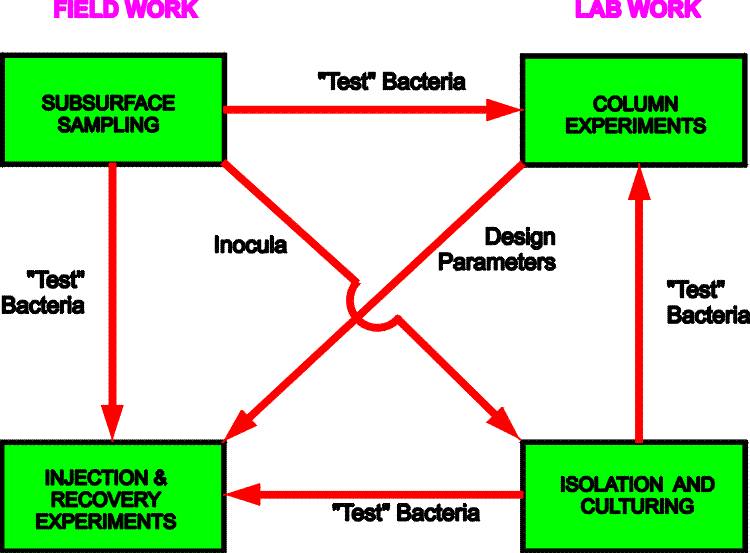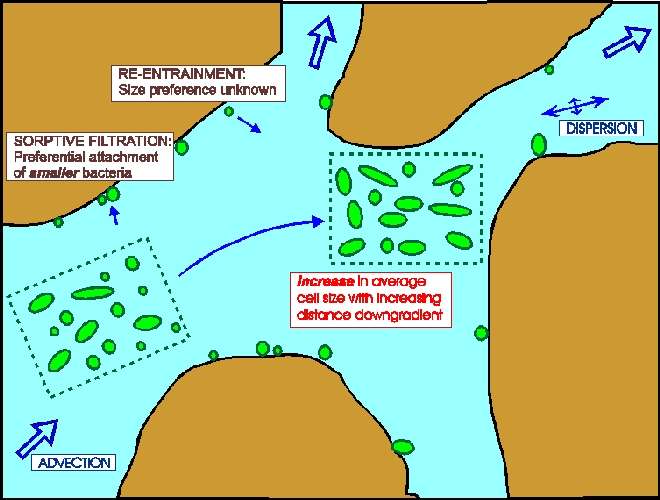|
|
|
|
|
|
PROJECT NUMBER: CR-94-327 PROJECT CHIEF: Ron Harvey
SHORT TITLE: Bacteria-Contaminant Interactions
PROJECT TITLE: Interaction of Bacteria with Environmental Contaminants and Solid Surfaces in the Aquatic Environment
PROBLEM:
Although efforts have been made to explain the behavior of heavy metals and refractory organic contaminants in aquatic habitats in the framework of known geophysical and geochemical processes, much remains to be learned about the role of bacteria in such behavior. Of particular interest are bacteria-contaminant interactions in ground water. Due to the persistence of some contaminants in the subsurface environment and to increasing demand for both high quality ground-water and on-land disposal of toxic chemicals and radioisotopes, these interactions should remain important environmental problems for the next few decades. Since significant biotransformation/biodegradation of many environmental contaminants in aquifers and particle-laden surface waters can occur at particle surfaces, explanations for bacteria-contaminant interactions in such environments should take the presence of particles into account.
OBJECTIVES:
Provide some of the microbiological information necessary for more realistic predictions of contaminant behavior in aquatic environments. Obtain information on specific mechanisms of interactions between environmental contaminants and aquatic bacteria, taking into account adsorption, active uptake competition, biotransformation reactions, interactions with extracellular polymers, effects of nutrient and physicochemical gradients, and effects of particle surfaces. Investigate the effect of nutrient and physicochemical conditions upon subsurface transport of bacteria since the role of bacterial transport upon the fate of environmental contaminants in ground water is unknown.
APPROACH:
The complex nature of interactions between
bacteria and organic and inorganic contaminants in particle-laden aquatic
habitats necessitates an approach involving both field and laboratory studies:
(1) Study of the influence of surfaces and interfaces upon microbial heterotrophic
activity in particle-laden aquatic environments, including fresh-water
aquifers. (2) Study of the effect of organic contaminants upon the distribution,
transport, and activity of the bacterial population in ground-water habitats.
These studies will be performed with Richard Smith, Water Resources Division
(WRD), Boulder. (3) Flow-through column experiments to assess the role
of adherent bacteria upon the mobility of selected heavy metals and toxic
organic compounds in simulated aquifer environments. Columns will be used
to investigate factors affecting the movement of bacteria through porous
media. (4) Microcosm studies of bacteria-contaminant interactions.
Back
to Home Page
|
|
|
|
|
|
GROUNDWATER MICROBIOLOGY & SUBSURFACE MICROBIAL TRANSPORT:
SURFACE WATER MICROBIOLOGY:
GROUNDWATER MICROBIOLOGY & SUBSURFACE MICROBIAL TRANSPORT:
Bales, R.C., Li, S., Maguire, K.M., Yahya, M.T., Gerba, C.P., and Harvey, R.W., 1995, Virus and bacteria transport in a sandy aquifer, Cape Cod, MA. Ground Water, Vol. 33, p. 653-651.
Harvey, R.W., Kinner, N.E., Bunn, A., MacDonald, D., and Metge, D., 1995, Transport behavior of groundwater protozoa and protozoa-sized microspheres in sandy aquifer sediments. Appl. Environ. Microbiol., Vol. 61, 209-217.
Loveland, J.P., Ryan, J.N., Amy, G.L., and Harvey, R.W., 1996, The reversibility of virus attachment to mineral surfaces. Colloid Surfaces. A: Physicochem. Eng. Aspects, in press.
Harvey, R.W., Metge, D.W., Kinner, N., and Mayberry, N., 1997, Physiological considerations in applying laboratory-determined buoyant densities to predictions of bacterial and protozoan transport in groundwater: Results of in-situ and laboratory tests. Environ. Sci. Technol., 31:289-295.
Pieper, A.P., Ryan, J.N., Harvey, R.W., Amy, G.L., Illangasekare, T.H., and Metge, D.W., 1997, Transport and recovery of bacteriophage PRD1 in a sand and gravel aquifer: Effect of sewage-derived organic matter. Environ. Sci. Technol. 31:1163-1170.
Harvey, R.W., Microorganisms as tracers in groundwater injection and recovery experiments: A review. FEMS Microbiol. Rev. 20:461-472.
Novarino, G., Warren, A., Butler, H., Lambourne, G., Boxshall, A., Bateman, J., Kinner, N.E., Harvey, R.W., Mosse, R.A., and Teltsch, B., Protistan communities in aquifers: a review. FEMS Microbiol. Rev. 20:261-275.
Kinner, N.E., Harvey, R.W.,
and Kazmierkiewicz-Tabaka, M., Effect of flagellates on free-living bacterial
abundance in an organically-contaminated aquifer. FEMS Microbiol. Rev.
20:247-259.
INVITED CHAPTERS (BOOKS):
Barber, L.B., Krueger, C., Metge, D.W.,
Harvey, R.W., and Field, J.A., 1995, Fate of linear alkylbenzene sulfonate
in groundwater: implications for in situ surfactant-enhanced remediation,
in Sabatini, D.A., Knox, R.C., and Harwell, J.H., eds., Surfactant-Enhanced
Subsurface Remediation: Washington, American Chemical Society, pp.
95-111
Harvey, R.W., 1997, In situ and
laboratory methods to study subsurface microbial transport. In Hurst, C.J.,
Knudsen, G.R., McInerney, M.J., Stetzenback, L.D., and Walter, M.V., eds.,
Manual of Environmental Microbiology: Washington, ASM Press, p.
586-599.
Harvey, R.W., Suflita, J.M., and
McInerney, M.J., 1997, Overview of issues in subsurface and landfill microbiology.
In Hurst, C.J., Knudsen, G.R., McInerney, M.J., Stetzenback, L.D., and
Walter, M.V., eds., Manual of Environmental Microbiology: Washington,
ASM Press, p. 523-525.
Back
to Home Page
 Click on picture for
further information
Click on picture for
further information
We
have concentrated on iterative lab and field experiments (figure above)
to investigate the multifaceted factors associated with microbial
(protozoa-virus-bacteria) transport in the subsurface and how geochemistry
affects them. The illustrations below describe what may be going
on at the microbial level.
Click
on either to see a larger picture.
 |
|
|
|
|
This USGS project's resources include two epifluorescent research microscopes with computer controlled image capture/sizing, full microbial culture capabilities with access to anaerobic chambers, an HPLC, and a state-of-the-art flow cytometer with real time microbial cell counting and sizing capabilities. Clean hood, high speed centrifuge, bacterial/protozoan/virus culture materials, and flow-column equipment are all available. We maintain several bacterial and virus stocks for use in injection and recovery experiments. We have recently begun to assay groundwater for pathogenic organisms (Cryptosporidium/Giardia, coliform, enteric virus, coliphage) and have some expertise in water quality assessments.
NSF project with University of New Hampshire and the British Museum of Natural History has focused on laboratory and field experiments. These were designed to understand the ecological role of protozoa in contaminated aquifers, describe mechanisms controlling protozoan transport in the subsurface, understand how protozoan-bacterial communities interact under contaminant conditions, and describe types of protozoa found in subsurface environments. The future of this work will focus on pathogenic protozoa (Cryptosporidium/Giardia) and how they become transported in aquifer environments. Findings have included the first taxonomy of subsurface protozoa, mechanisms controlling the rate of protozoan transport, grazing rates of protozoa upon the bacterial community, carefully monitored changes in population dynamics, and advancements in proper culture techniques for isolation and characterization of subsurface protozoa.
EPA-funded project with CU - Boulder works on the mechanisms controlling viral transport in subsurface environments. Work has included injection and recovery experiments at the Cape Cod Toxics Site with single and dual radioisotope-labeled bacteriophage (nonpathogenic). These experiments were designed to help understand the mechanisms of viral sorption, desorption, inactivation, and transport within both contaminated and uncontaminated regions. Findings have included viral sorption-desorption kinetics, influence of surfactants upon viral transport, and rates of viral inactivation in subsurface systems.
USGS Massachusetts District collaboration has focused upon the mechanisms
controlling bacterial transport with both cultured isolates and indigenous
bacterial populations within contaminated and uncontaminated regions of
the Cape Cod Aquifer. Findings have included widely cited parameters for
bacterial transport and methods used in injection and recovery experiments.
Additionally, coupled field and laboratory experiments have helped better
understand the importance of specific mechanisms such as sorption-desorption,
microbial buoyant density, and pH have in controlling bacterial transport.